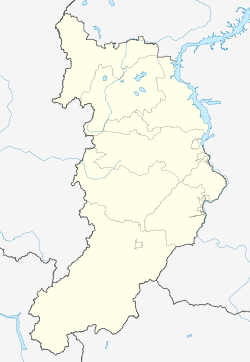Maina (Khakassia)
| Urban-type settlement
Maina
Майна
|
||||||||||||||||||||||||||||||
|
||||||||||||||||||||||||||||||
|
||||||||||||||||||||||||||||||
Maina ( Russian Майна ) is an urban-type settlement in the Republic of Khakassia ( Russia ) with 5062 inhabitants (as of October 14, 2010).
geography
The settlement is located in the valley of the Yenisei through the West Sayan , about 80 kilometers (as the crow flies) south of the republic capital Abakan on the left bank of the river, which here forms the border to the Krasnoyarsk region. To the south of the settlement, the Yenisei is dammed up to form the small Maina reservoir , which is preceded by the Sajano-Schuschensker reservoir a good 20 kilometers upstream . To the southeast of the settlement, the mountains in the Borus ridge with Mount Poilowa rise to an altitude of 2318 m .
Maina belongs to the urban district of some 10 kilometers downstream, at the opening of the narrow valley to the far minusinsk hollow , located Sajanogorsk .
history
In 1732 or 1736, a copper ore mine was built in the mountains west of today's settlement and in this context the first settlement in this part of the Yenisei valley. Were named mine (Mainski rudnik) and place under the Maina - rapids , which has formed the flow here in the region of the aperture by the Sajankämme. The mine was closed again in 1750 due to unprofitability.
With the resumption of mining and the planned further industrialization of the area, the place was rebuilt in 1946 as a workers' settlement and in 1957 received the status of an urban-type settlement.
The new Maina copper mine with a nearby enrichment factory was in operation from 1950 to 1963, when the richest ores had already been mined. With the construction of the Sajano-Schuschensk hydropower plant and an aluminum plant near today's Sajanogorsk, which were planned for the first time in the 1930s and started in the 1960s, further workers' settlements were built near the construction sites, which initially belonged to Maina. Its population therefore grew to over 10,000. In 1974 the settlement near the hydroelectric power station became independent under the name of Cheryomushki . In 1975, the settlement that emerged from the village of Osnatschennoje at the aluminum works was given town charter as Sajanogorsk, and Maina and Tscherjomuschki were administratively subordinate to the now much larger Sajanogorsk.
Population development
| year | Residents |
|---|---|
| 1959 | 4,569 |
| 1970 | 13,656 |
| 1979 | 8,547 |
| 1989 | 6.328 |
| 2002 | 5,365 |
| 2010 | 5,062 |
Note: census data
Culture and sights
The main attraction is the nature of the surrounding Sajan Mountains. The area east of the Yenisei is part of the Shushensky Bor National Park .
In the area of the dam of the reservoir of the old Maina-located on the right bank remains Khakassian Wallenburg Lubsanow whale . On the left bank, during excavations as part of the construction of the dam, a Upper Paleolithic deposit was discovered with an approximately 20,000 year old burnt clay figure, the oldest ceramic found in Russia to date, which is now in the St. Petersburg Hermitage .
Economy and Infrastructure
The most important company is the smaller Maina hydropower plant, operated by RusHydro today and built between 1979 and 1987 to regulate the discharge of the Sajano-Schuschensk reservoir and to generate additional electrical energy.
South of the village, high above the left bank of the Yenisei, a quarry has been in operation since 1973 on the Kibik-Kordon (Kibik-Kordonskoje) marble deposit, which was known since the 18th century and was first described in more detail in the mid-19th century . For several years, MKK-Sajanmramor has also been operating underground mining. Kibik cordon marble, for example, was used in the decoration of the Moscow metro stations Krylatskoje , Domodedowskaja and Bulwar Dmitrija Donskogo , which opened in the 1980s to 2000s .
The regional road R411 runs through the settlement, which , starting from Abakan, follows the Yenisei via Sayanogorsk to Cheryomushki on the M54 Krasnoyarsk - Kyzyl - Mongolian border .
Individual evidence
- ↑ a b Itogi Vserossijskoj perepisi naselenija 2010 goda. Tom 1. Čislennostʹ i razmeščenie naselenija (Results of the All-Russian Census 2010. Volume 1. Number and distribution of the population). Tables 5 , pp. 12-209; 11 , pp. 312–979 (download from the website of the Federal Service for State Statistics of the Russian Federation)
- ↑ Republic of Khakassia ( Memento of the original from April 2, 2007 in the Internet Archive ) Info: The archive link was automatically inserted and not yet checked. Please check the original and archive link according to the instructions and then remove this notice. from the series Panorama of the Cultural Life of the Regions of Russia on the Internet of the Russian State Library , 2003 (Russian)
- ↑ History of industrial development in the Sajanogorsk web portal (Russian)
- ↑ Clay figure from Maina ( Memento of the original from January 1, 2009 in the Internet Archive ) Info: The archive link has been inserted automatically and has not yet been checked. Please check the original and archive link according to the instructions and then remove this notice. on the website of the Hermitage (English, photo)
- ^ Vyacheslav Swerew: Gemstone in Architecture and Construction in Promyshlennyye Vedomosti from October 10, 2005 (Russian)
literature
- Kirill Skorobogatʹko (Ed.): Chakasija . 2nd Edition. Petit Futé, Avangard, Moscow 2006, ISBN 5-86394-202-9 , pp. 31, 171-172 (Russian).

